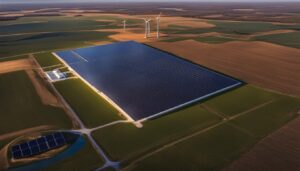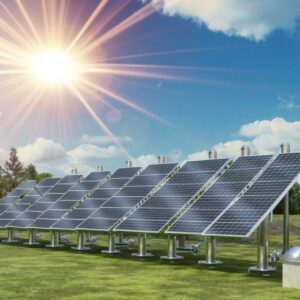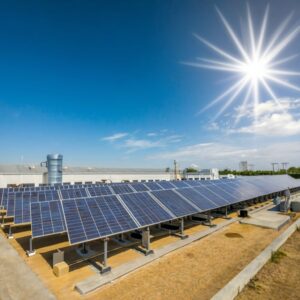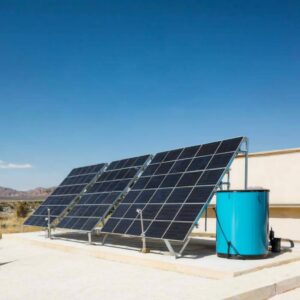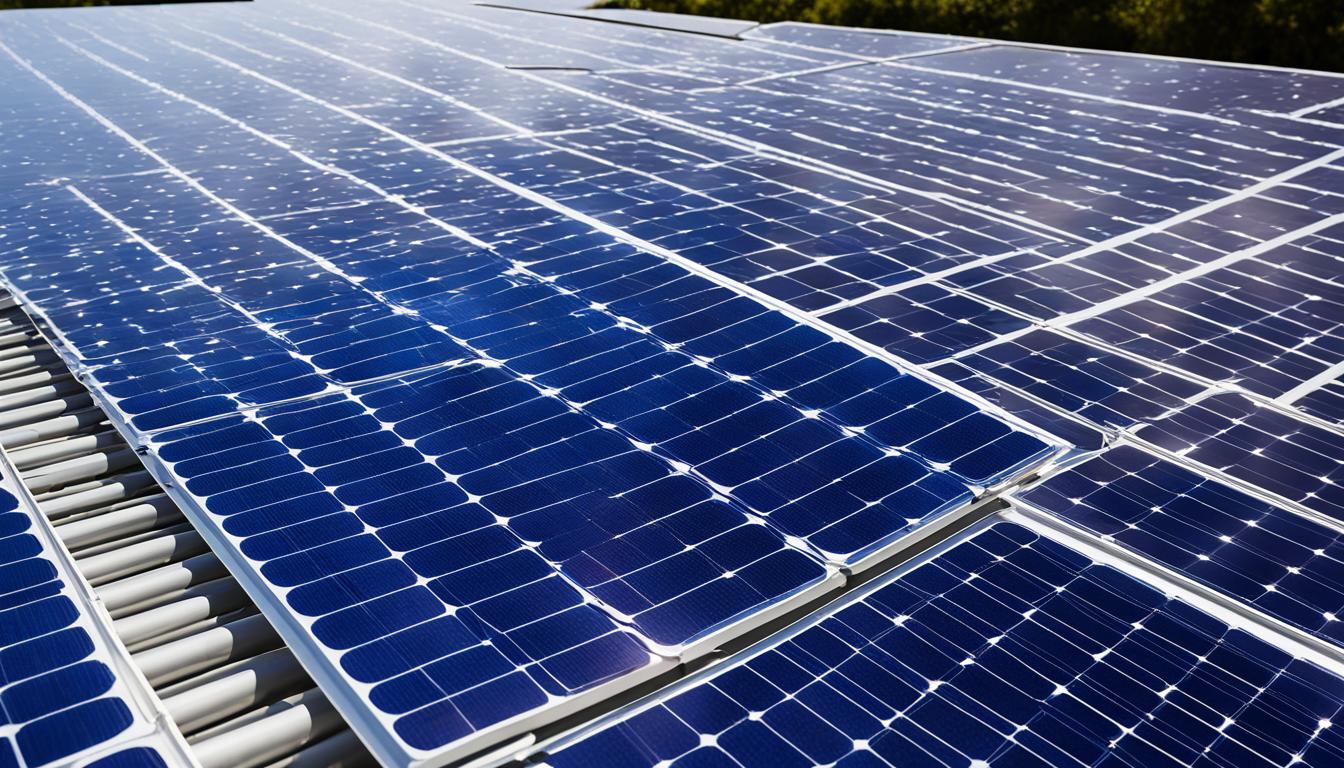
As we witness a shift towards cleaner and more sustainable energy sources, solar power has emerged as a frontrunner in the race for renewable electricity generation. At the core of solar power systems are photovoltaic cells, commonly known as solar cells, playing a pivotal role in converting sunlight into electricity. In this article, we will dive deep into the working principles of photovoltaic cells and unravel the science behind solar power.
Key Takeaways
- Photovoltaic cells are responsible for converting sunlight into electricity in a sustainable manner.
- The working of photovoltaic cells involves processes like sunlight absorption, electric field creation, and electric current generation.
- Understanding the fundamental principles of photovoltaic cell working is crucial for comprehending solar power generation.
- Solar power systems play a vital role in the production of renewable and sustainable electricity.
- Photovoltaic cells will continue to be at the heart of the solar power revolution as the world moves towards cleaner energy sources.
Absorption of Sunlight and Creation of Electric Field
The process of converting sunlight into electricity begins with the absorption of sunlight by the photovoltaic cell. The cell is made of a semiconductor material, typically silicon, that has the ability to generate electricity when exposed to light. When photons from sunlight strike the cell, they transfer their energy to the electrons in the semiconductor material, causing them to become energized or excited.
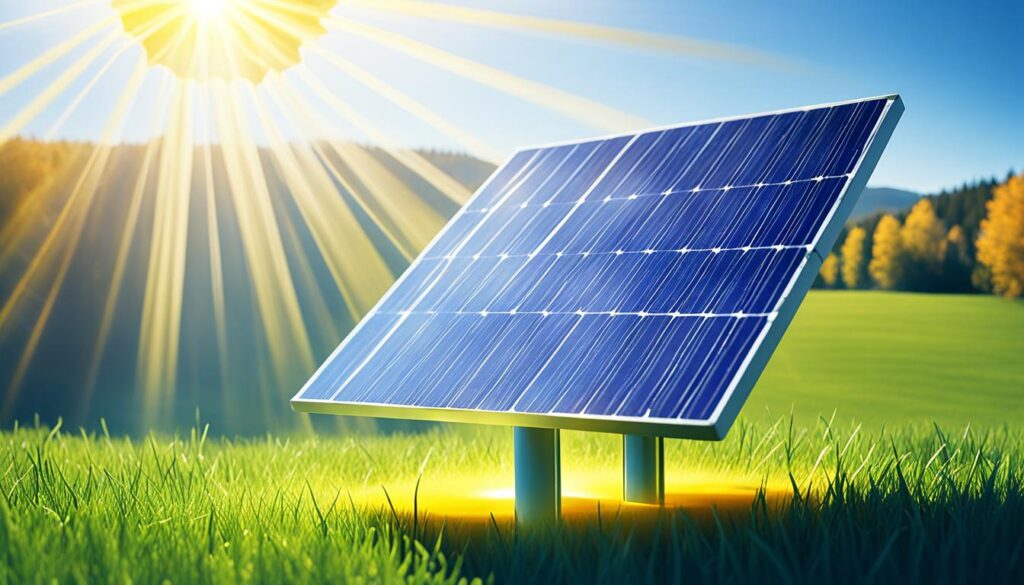
This excitation of electrons in the semiconductor material creates an electric field within the cell. The cell is designed with a p-n junction, which is the interface between the two different types of semiconductor material: the p-type and the n-type. The p-n junction plays a critical role in the creation of an electric field.
The p-n junction creates a built-in electric field due to the difference in charge carriers on either side. This electric field acts as a barrier for the movement of electrons and holes, allowing for the separation of charges and the creation of a potential difference.
The creation of an electric field is a crucial step in the functioning of a photovoltaic cell. It sets the stage for the subsequent movement of charged particles and the generation of electric current, which will be explored in the next section.
Generation of Electric Current and Power Output
Once the electric field is established, it allows for the movement of charged particles within the cell. The energized electrons, due to the electric potential difference, flow from the n-type region to the p-type region, creating an electric current. This flow of electrons constitutes the generation of electricity in the form of direct current (DC) within the photovoltaic cell.
As the electrons flow from the n-type region to the p-type region, they transfer their energy to the external circuit, where it can be harnessed to power various devices. The magnitude of the electric current depends on factors such as the intensity of sunlight, the surface area of the photovoltaic cell, and the efficiency of the conversion process.
The power output of a photovoltaic cell is determined by the product of the generated current and the voltage. The greater the current and voltage, the higher the power output. This power output can be optimized through various techniques, including improving the design of the cell, enhancing light absorption, and reducing energy losses.
The efficiency of a photovoltaic cell refers to the ratio of the electrical power output to the incident sunlight power. It is a measure of how effectively the cell converts sunlight into electricity. Higher efficiency results in greater power generation and more effective utilization of the available sunlight.
“The generation of electric current and the power output of a photovoltaic cell are crucial factors in evaluating the performance and effectiveness of solar power systems. By understanding and enhancing the electron flow and efficiency of photovoltaic cells, we can unlock the full potential of solar energy.”
Advantages of Direct Current (DC)
Direct current (DC) is the type of electrical current generated by photovoltaic cells. Unlike alternating current (AC), which periodically changes direction, DC flows steadily in one direction. This characteristic of DC brings several advantages in the context of solar power:
| Advantages of Direct Current (DC) |
|---|
| Efficient for battery storage systems |
| Compatible with many electronic devices and appliances |
| Reduced energy losses during transmission |
| Less complex and costly conversion process for some applications |
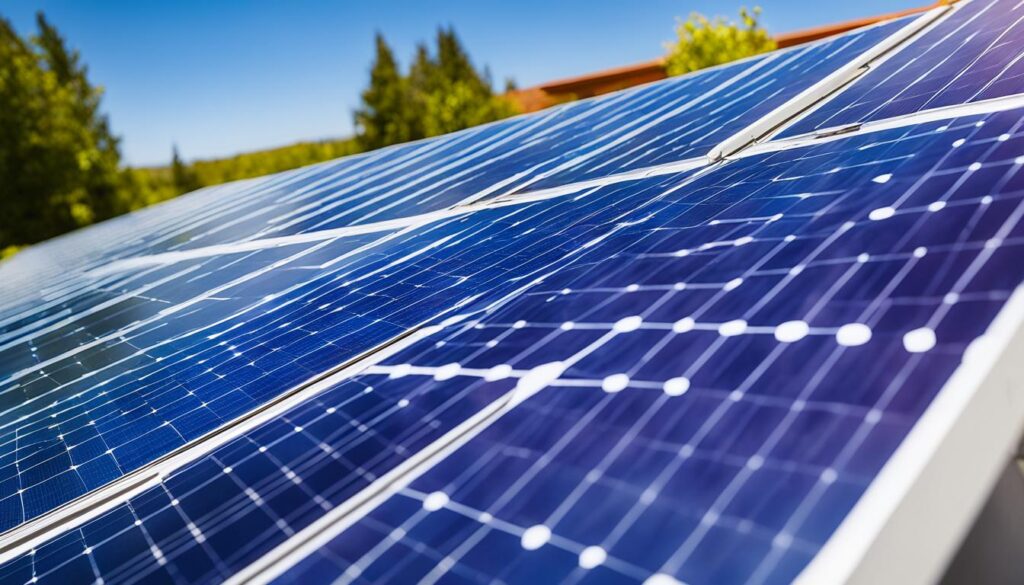
Maximizing Power Output and Efficiency
To maximize the power output and efficiency of a photovoltaic cell, several factors can be taken into consideration:
- Optimizing the design and composition of the photovoltaic cell to enhance sunlight absorption and electron excitation
- Incorporating anti-reflective coatings to reduce loss of incoming sunlight
- Implementing tracking systems that allow the cell to follow the sun’s movement for greater exposure
- Improving the conductivity of the materials used in the cell
- Minimizing energy losses through better encapsulation techniques
- Using multiple layers or junctions to capture a broader spectrum of sunlight
Conclusion
Understanding how photovoltaic cells work is essential in comprehending the foundations of solar power generation. By harnessing the ability of these cells to convert sunlight into electricity, solar power systems play a crucial role in producing renewable and sustainable electricity. The intricate processes involved in the working of photovoltaic cells, including sunlight absorption, the creation of an electric field, and the generation of electric current, are interconnected and vital for efficient energy conversion.
As the world transitions to cleaner and greener energy sources, photovoltaic cells will continue to be at the heart of the solar power revolution. Their ability to transform solar energy into usable electricity makes them the backbone of renewable energy systems. By utilizing the power of the sun, we can reduce our reliance on fossil fuels and combat the environmental challenges associated with traditional power generation.
Solar power, driven by photovoltaic cells, not only provides a sustainable solution for electricity needs but also helps reduce carbon emissions, dependence on non-renewable resources, and the impact of climate change. Embracing solar power as a viable alternative contributes to a cleaner and brighter future for generations to come. With constant advancements in the field of photovoltaic cell technology, we can further optimize the efficiency and effectiveness of solar power systems, making them even more accessible and affordable for widespread adoption.
FAQ
How does a photovoltaic cell work?
A photovoltaic cell works by converting sunlight into electricity. The cell is made of a semiconductor material, typically silicon, which generates electricity when exposed to light. When sunlight strikes the cell, it energizes the electrons in the material, creating an electric field and generating an electric current.
What is the role of sunlight absorption in photovoltaic cells?
Sunlight absorption is a crucial process in photovoltaic cells. When photons from sunlight hit the cell, they transfer their energy to the electrons in the semiconductor material, causing them to become excited. This excitation initiates the flow of electrons and the generation of electricity.
How is the electric field created in photovoltaic cells?
The electric field in photovoltaic cells is created through a p-n junction, also known as a semiconductor junction. This junction is formed by combining two types of semiconductor material, an n-type and a p-type. The electric field allows for the movement of charged particles within the cell, enabling the flow of electrons and the generation of electric current.
What is the difference between direct current (DC) and alternating current (AC)?
Direct current (DC) is the type of electricity generated by photovoltaic cells. It flows in one direction, maintaining a constant voltage and current. Alternating current (AC), on the other hand, periodically changes direction and voltage. AC is commonly used for power transmission and distribution in electrical grids.
How is electric current generated in photovoltaic cells?
Electric current is generated in photovoltaic cells through the flow of electrons. The energized electrons, due to the electric potential difference, move from the n-type region to the p-type region within the cell. This flow of electrons constitutes the generation of electricity in the form of direct current (DC).
What is the power output of photovoltaic cells?
The power output of photovoltaic cells refers to the amount of electricity they can generate. It is measured in watts (W) and depends on various factors, including the size and efficiency of the cells. The power output determines the electrical energy that can be harnessed from solar power systems.
Are photovoltaic cells a renewable energy source?
Yes, photovoltaic cells are a renewable energy source. They harness the power of sunlight, which is an abundant and renewable resource. By converting sunlight into electricity, photovoltaic cells contribute to the production of clean and sustainable energy.


